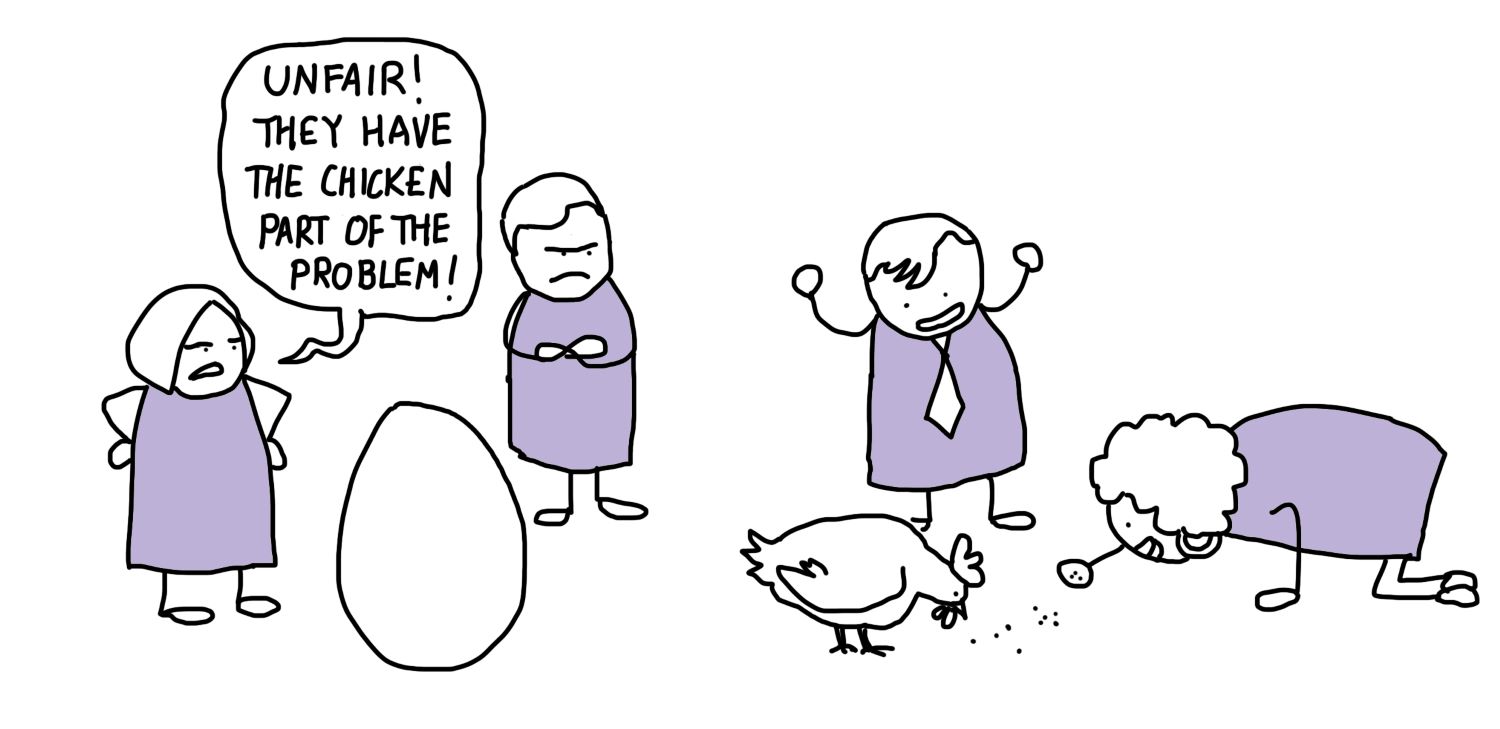Lock-ins and interdependencies: the chicken or the egg? (Part 2)
Every organisation involved in the practice of the circular economy has to face it: situations that end up being a stalemate, where external factors have to change first before we can move forward, where different parties are waiting for each other because they are interdependent. We clarify these situations using chicken-and-egg allegories.
You want to market circular products and services, but customers are not prepared to pay the higher cost associated with this. Do we need to increase customer demand or improve supply?
You want to engage in collaboration to reuse discarded products, but regulations do not allow it. Should the regulations change or should products not turn into waste after use?
There are many of these chicken-and-egg situations, which may give you the impression that no progress can be made. However, there is a way forward.
In the first article, we learned how chickens can change their perspective through their freedom of movement and how eggs grow from the inside out until the shell breaks, allowing the chick to hatch. But what if the chicken doesn't want the egg to break?
This type of deadlock can be solved only if both parties are truly willing to understand each other's views, values and goals. If there is room for dialogue and openness to learn, you can find common goals such as lifetime extension, cost-effective solution, functionality without negative impact on the environment, increased revenue without additional costs, access to new markets, increased reuse, etc. In these cases, the egg breaks, with the approval of the chicken who is excited about the hatching of a chick.
Sometimes the chicken doesn't want the egg to break
Not everything is always a success. Sometimes you fail to find a large enough common ground necessary to grow your circular idea.
In that case, find other allies within the organisation (egg) but outside the regulators, policymakers, or your management, etc. (chicken), and start small exploratory actions with that inner group of like-minded people. In many cases, this will allow you to quietly break existing boundaries by taking actions without explicit approval. Perhaps you risk stepping on someone's toes in the process ... The trick is to go far enough to learn and demonstrate for yourself that your idea is not so crazy after all, while making sure the risks, that you are undoubtedly taking or generating for your organisation, are not getting too big. Decathlon's 'We play circular' programme led by Luc Teerlinck also overcame such situations, before it led to an initial field test of 70 pilot customers and was scaled up. As such, it is one of the elements of the success analysis you will find in our article on why you should not set out on the road to the circular economy alone.
An example: A product discarded by the customer is essentially waste. You are not allowed to transport waste without the proper licence. You would like to dismantle one machine at your site to learn from it or test something on it. On paper, you cannot transport this machine yourself. If you agree with the customer that you’ll inspect the machine for repairability, you can however transport this machine, provided the customer has not yet scrapped it. In practice, the physical transport is identical in both cases. Will you let yourself be held back from transporting one machine in order to expand your knowledge or test your hypothesis Obviously, this is a problem you want to solve if you really want to start taking back commercially for remanufacturing. But you are not that far yet.
You may 'disobey' for one particular action, ignore advice or take the action anyway without approval. Always build a solid reasoning and argumentation as to why you are taking this action anyway. This reasoning is the basis of ongoing consultation with the other stakeholders. It is also the core of what you want to demonstrate or what you will learn.
It is quite possible that your test does not go as planned. In this case, you commit yourself to making the lessons learned explicit and sharing them. This is a pivotal moment, where new insights lead you to new assumptions and new tests. Be careful not to blur relationships. After all, this is not about being right, the core is learning together and making progress towards circular goals.
You can also create a rule-free environment, in which you conduct tests outside regular structures. So you look for a context in which you can remove the rules (limiting obstacles) of your potential partners, for example.
|
Chicken-and-egg situations summarised
- Don't accept that the chicken or the egg paralyses you.
- Change the perspective, pull it open and take an iterative approach based on what is already there and working well.
- Explore contradictions and look for equal goals as a stepping stone to small changes.
- Break the rule, stretch the limit to just before it becomes too dangerous or risky.
- Sometimes you have to be a bit disobedient, to demonstrate circular potential.
- Relationships are everything: keep them intact at all times.
- Document your reasoning and assumptions, and use them as a basis for ongoing consultation.
Want to know more about how to tackle circular lock-in situations in practice? Get in touch with us!
This article was written as part of the COOCK project Circle: setting up activities aimed at product life extension, and the related challenges.







